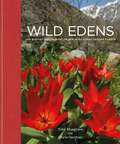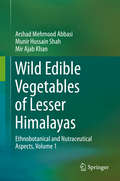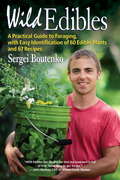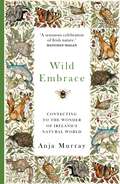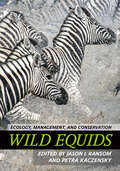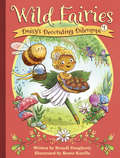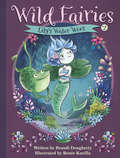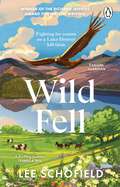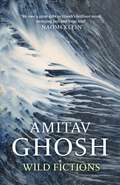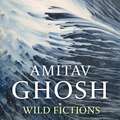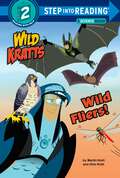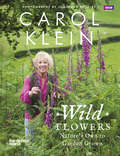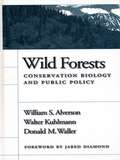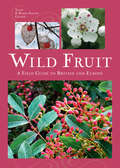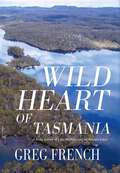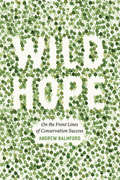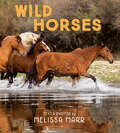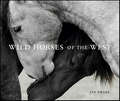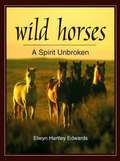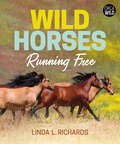- Table View
- List View
Wild Ecosystems, Unit 6: Nature's Neighborhoods
by Wright Group/McGraw-HillThis is a textbook about the connection of living things in the wild ecosystem.
Wild Edens
by Chris Gardner Toby MusgraveOrnamental plants are the cornerstone of our gardens and we are spoiled for choice with literally tens of thousands of hardy beauties from which to select. But we take them absolutely for granted, not for a moment realising that every plant has a fascinating tale to tell. Wild Edens sets the record straight. With global coverage, each of the nine richly illustrated chapters explores a plant biodiversity hotspot. The reader is transported on a visually stunning and fascinating voyage of discovery which reveals our garden favourites - as well as some species that should be more widely cultivated - in their natural habitats, from daffodils from Andalusia and tulips from the Tien Shan, to monkey puzzles from Chile and rhododendrons from the Himalayas, lilies from Japan and proteas from South Africa.Because the authors have been to the hotspots, each chapter opens with their personal reflections on the landscape and spirit of place, and closes with their selection of prime locations. In between, the informative yet approachable text tells of the plants' 'forgotten stories'. Of the landscapes which are their home, the adventures of how and when they were discovered and by whom, the reasons why they were collected, their impact on garden fashions and trends, etc. Wild Edens brings another dimension of interest and understanding to plants and gardens, as well as being a premium armchair traveller's guide to the natural world of garden plants.
Wild Edible Vegetables of Lesser Himalayas
by Mir Ajab Khan Arshad Mehmood Abbasi Munir Hussain ShahOur intention with this book was to present the reader with the most accurate, significant, and up-to-date background and knowledge in the areas of ethnomedicinal and nutraceutical vegetation for the Lesser Himalayas in a comprehensive text. Wild Edible Vegetables of Lesser Himalayas provides a complete review of over 50 important plants of this region and details each species including photographs, botanical name, local name, family, flowering and fruiting period, status and habitat, parts used, distribution, ethnobotanical uses, cultural aspects, medicinal uses, and nutraceutical aspects. Medicinal uses include mode of preparation, method of application and diseases studied; cultural aspects and index; nutraceutical data provides analysis of fats, proteins, fibers, carbohydrates, ash, moisture content, dry matter, and energy value; elemental analysis includes various essential and toxic metals; phytochemical screening includes total phenolics, flavonoids, flavonols and ascorbic acid, and antioxidant potential in terms of DPPH scavenging activity, hydroxyl radical scavenging activity, H2O2 scavenging activity, Fe2+ chelating activity, ferric reducing antioxidant power, and phosphomolybdenum assay for each species. Wild Edible Vegetables of Lesser Himalayas is a concise and handy guide for scientists, scholars, and students interested in the study of agriculture, food science, nutraceutical science, bioscience, biodiversity, applied ethnobotany, ethnoecology, and ecology.
Wild Edibles
by Sergei BoutenkoIn this field guide to foraging wild edible plants, Sergei Boutenko (son of raw-food guru Victoria Boutenko) explores the health benefits of wild-harvested food, explains how to safely identify trailside weeds, herbs, fruits, and greens that grow worldwide, and shares his delicious, nutrient-dense recipes.Sergei Boutenko has been gathering wild plants since he was 13, when, early on in a 6-month hike from Mexico to Canada, he and his raw-food family ran out of provisions and turned to foraging for survival in the wild. Back in civilization, Boutenko was dismayed by the inferior quality of store-bought food and industrial agriculture, and began to regularly collect wild plants near his home and on his travels. Now, in Wild Edibles, he shares knowledge gleaned from years of live-food wildcrafting and thriving in harmony with nature.This practical guide to plant foraging gives hikers, backpackers, raw foodists, gardeners, chefs, foodies, DIYers, survivalists, and off-the-grid enthusiasts the tools to identify, harvest, and prepare wild edible plants. The book outlines basic rules for safe wild-food foraging and discusses poisonous plants, plant identification protocol, gathering etiquette, and conservation.Boutenko explores in detail the many rewards of eating wild flora: environmental protection, sustainability, saving money, economic self-sufficiency, and healthy living. He draws on thoroughly researched nutrition science to make a compelling case for the health benefits of a diverse, local-food diet that includes wild greens.The majority of the 60 edible plants described in this field guide can be found worldwide, including common-growing trees. Over 300 color photos make plant identification easy and safe. A chapter containing 67 high-nutrient vegan recipes--including green smoothies, salads and salad dressings, spreads and crackers, main courses, juices, and sweets--provides inspiration to join Sergei on the trail to radiant health."Wild Edibles: A Practical Guide to Foraging, with Easy Identification of 60 Edible Plants and 67 Recipes has taught me that my backyard is full of free food! Way to go, Sergei." --John Mackey, CEO of Whole Foods MarketFrom the Trade Paperback edition.
Wild Embers: Poems Of Rebellion, Fire, And Beauty
by Nikita Gill"You cannot burn awayWhat has always been aflame"Wild Embers explores the fire that lies within every soul, weaving words around ideas of feeling at home in your own skin, allowing yourself to heal, and learning to embrace your uniqueness with love from the universe. Featuring rewritten fairytale heroines, goddess wisdom, and poetry that burns with revolution, this collection is an explosion of femininity, empowerment, and personal growth.
Wild Embrace: Connecting to the Wonder of Ireland's Natural World
by Anja Murray'Gorgeous ... a joyful reminder that there are still wonders to be found in Ireland wherever we give nature an inch to flourish' IRISH INDEPENDENT'From moss to moths, Anja Murray has conjured up an ebullient paean to our surrounding ecosystem - a sensuous celebration of nature.' MANCHÁN MAGAN'A hugely important, and simply delightful, book.' EOGHAN DALTUN, author of An Irish Atlantic RainforestOPEN UP TO A NOURISHING NEW RELATIONSHIP WITH IRELAND'S WILD WORLD.Wild Embrace is about cultivating curiosity and awe in nature, in a time of eco-anxiety and overwhelm. As ecologist Anja Murray opens our eyes to the hidden bounty of the land, sea and sky around us, we head out on a unique journey through the Irish landscape.She explores the joy of foraging, the marvels of Irish birds, the roles of our native trees in environmental regeneration, nature at night and in the city, and much more - including fascinating insights into our ecological past.With beautiful illustrations by Jane Carkill (@lamblittle), Wild Embrace awakens our senses to the everyday environmental wonders within reach, as we set out on a path to empowered change into the future.
Wild Embrace: Connecting to the Wonder of Ireland's Natural World
by Anja Murray'Gorgeous ... a joyful reminder that there are still wonders to be found in Ireland wherever we give nature an inch to flourish' IRISH INDEPENDENT'From moss to moths, Anja Murray has conjured up an ebullient paean to our surrounding ecosystem - a sensuous celebration of nature.' MANCHÁN MAGAN'A hugely important, and simply delightful, book.' EOGHAN DALTUN, author of An Irish Atlantic RainforestOPEN UP TO A NOURISHING NEW RELATIONSHIP WITH IRELAND'S WILD WORLD.Wild Embrace is about cultivating curiosity and awe in nature, in a time of eco-anxiety and overwhelm. As ecologist Anja Murray opens our eyes to the hidden bounty of the land, sea and sky around us, we head out on a unique journey through the Irish landscape.She explores the joy of foraging, the marvels of Irish birds, the roles of our native trees in environmental regeneration, nature at night and in the city, and much more - including fascinating insights into our ecological past.With beautiful illustrations by Jane Carkill (@lamblittle), Wild Embrace awakens our senses to the everyday environmental wonders within reach, as we set out on a path to empowered change into the future.
Wild Equids: Ecology, Management, and Conservation
by Jason I. Ransom Petra KaczenskyThe first expert synthesis of the diverse studies conducted on wild equids worldwide.Wild horses, zebras, asses, and feral equines exhibit intriguing and complex social structures that captivate the human imagination and elicit a wide range of emotions that influence conservation and management efforts. This book, spearheaded by Jason I. Ransom and Petra Kaczensky, brings together the world's leading experts on equid ecology, management, and conservation to provide a synthesis of what is known about these iconic species and what needs to be done to prevent losing some of them altogether. The most comprehensive conservation book on wild equids in decades, this title will enlighten not only equid researchers, but also mammalogists, conservationists, and equine professionals. Readers will find new insight into the lives of the world's horses, zebras, and asses, understand the basis of our relationships with these animals, and develop a greater understanding of where equids come from and why they are worth conserving.Included in this book are detailed, state-of-the-science syntheses on Social structure, behavior, and cognition Habitat and diet Ecological niches Population dynamics Roles of humans in horse distribution through time Human dimensions and the meaning of wild Management of free-roaming horses Captive breeding of wild equids Conservation of wild equids Conservation of migrations Reintroductions Genetics and paleogenetics
Wild Fairies #1: Wild Fairies #1 (Wild Fairies #1)
by Brandi Dougherty Renee KurillaMeet the Wild Fairies, a group of magical fairy friends who love playing and learning in the beautiful and bountiful forest they call home. With their reliable critter companions always by their side, Daisy, Thistle, Heather, Celosia, Poppy, Dahlia, Indigo, and Lily care for the natural world around them using their unique and diverse set of special skills. Infused with ecology, botany, and magic, the wild fairies’ whimsical adventures will inspire in kids a sense of wonder and curiosity for nature, as well as inform them about the wildflowers and critters behind the fairies through young-reader friendly nonfiction pages in the back of each book.In the first installment of the Wild Fairies series, Daisy’s Decorating Dilemma, spring is in the air in Sugar Oak! Green buds grow on the trees, the temperature’s warm, and all of the fairies’ animal friends have come out to play. But before the fairies can smell the flowers and soak in the sun, they must plan the biggest party of the year—the Blossom Bash! Normally, Daisy would LOVE leading her fairy friends, but when each of the fairies has a different vision for the bash’s decorations, she’s left stumped. Thistle wants thistle flowers! Dahlia wants dahlias! And Poppy wants LOTS of red. Daisy has a difficult decision to make, and with first bloom right around the corner, she better decide fast.
Wild Fairies #2: Wild Fairies #2 (Wild Fairies #2)
by Brandi Dougherty Renee KurillaThe second installment of the Wild Fairies series, Lily’s Water Woes, follows wild fairy (and mermaid) Lily, who is feeling left out. While her fairy friends get to travel to beautiful beaches and lush forests, Lily is always stuck at home, unable to be away from the water for very long. Her froggy pal, Splash, tries his best to cheer her up, but Lily still wishes she could stay out late and play like the other fairies. Wanting to help their friend, the fairies come together to build an awesome surprise for Lily that just might make it easier for her to travel beyond her small pond.The Wild Fairies series features a group of magical fairy friends who love playing and learning in the beautiful and bountiful forest they call home. With their reliable sidekick critters alongside, Daisy, Thistle, Heather, Celosia, Poppy, Dahlia, Indigo, and Lily care for the natural world around them using their unique and diverse set of special skills. Infused with ecology, botany, and magic, the wild fairies’ whimsical adventures will inspire in kids a sense of wonder and curiosity for nature, as well as inform them about the wildflowers and critters behind the fairies through young-reader friendly nonfiction pages in the back of each book.
Wild Fell: Fighting for nature on a Lake District hill farm
by Lee Schofield'I found myself turning the pages with an inward leap of joy' - Isabella Tree*WINNER of the Richard Jefferies Award for Nature Writing**Shortlisted for the James Cropper Wainwright Prize for Conservation*'Exquisite' GUARDIANIt was a tragic day for the nation's wildlife when England's last and loneliest golden eagle died in an unmarked spot among the remote eastern fells of the Lake District. But the fight to restore the landscape had already begun.Lee Schofield, ecologist and site manager for RSPB Haweswater, is leading efforts to breathe life back into two hill farms and their thirty square kilometres of sprawling upland habitat.Informed by the land, its turbulent history and the people who have shaped it, Lee and his team are repairing damaged wetlands, meadows and woods. Each year, the landscape is becoming richer, wilder and better able to withstand the shocks of a changing climate.But in the contested landscape of the Lake District, change is not always welcomed, and success relies on finding a balance between rewilding and respecting cherished farming traditions. This is not only a story of an ecosystem in recovery, it is also the story of Lee's personal connection to place, and the highs and lows of working for nature amid fierce opposition.
Wild Fictions
by Amitav GhoshWild Fictions brings together Amitav Ghosh's extraordinary writing on the subjects that have obsessed him over the last twenty-five years: literature and language; climate change and the environment; human lives, travel, and discoveries. The spaces that we inhabit, and the way in which we occupy them, is a constant thread throughout this striking and expansive collection.From the significance of the commodification of the clove, the diversity of the mangrove forests in West Bengal and the radical fluidity of multilingualism, Wild Fictions is a powerful refutation of imperial violence, a fascinating exploration of the fictions we weave to absorb history, and a reminder of the importance of empathy. With the combination of moral passion, intellectual curiosity and literary elegance that defines his writing, Amitav Ghosh makes us understand the world in new, and urgent, ways. Together, the pieces within Wild Fictions chart a course that allows us to heal our relationships and restore a delicate balance with the volatile landscapes to which we all belong.'We owe a great debt to Ghosh's brilliant mind, avenging pen, and huge soul' NAOMI KLEIN, author of This Changes Everything
Wild Fictions
by Amitav Ghosh'Brims with ideas and insights . . . Ghosh is at his sparkling best' IRISH TIMESWild Fictions brings together Amitav Ghosh's extraordinary writing on the subjects that have obsessed him over the last twenty-five years: literature and language; climate change and the environment; human lives, travel, and discoveries. The spaces that we inhabit, and the way in which we occupy them, is a constant thread throughout this striking and expansive collection.From the significance of the commodification of the clove, the diversity of the mangrove forests in West Bengal and the radical fluidity of multilingualism, Wild Fictions is a powerful refutation of imperial violence, a fascinating exploration of the fictions we weave to absorb history, and a reminder of the importance of empathy. With the combination of moral passion, intellectual curiosity and literary elegance that defines his writing, Amitav Ghosh makes us understand the world in new, and urgent, ways. Together, the pieces within Wild Fictions chart a course that allows us to heal our relationships and restore a delicate balance with the volatile landscapes to which we all belong.'We owe a great debt to Ghosh's brilliant mind, avenging pen, and huge soul' NAOMI KLEIN, author of This Changes Everything
Wild Fliers! (Step into Reading)
by Chris Kratt Martin KrattPBS's successful animated show Wild Kratts joins the adventures of zoologists Chris and Martin Kratt as they travel to animal habitats around the globe. Along the way, they encounter incredible creatures while combining science education with fun. Boys and girls 4 to 6 can learn all about birds, bats, and other amazing creatures that fly in this leveled reader! Step 2 readers use basic vocabulary and short sentences to tell simple stories for beginning readers who recognize familiar words and can sound out new words with help.
Wild Flowers: Nature's own to garden grown
by Carol KleinWild flowers are a great passion for Carol, and for the TV show this year she’s travelling the length and breadth of the country to find the most exquisite flora occurring naturally in our woodlands, hedgerows, meadows and moors, and then she sets off in search of their cultivated cousins, and shows us how to grow them in our own gardens. In her accompanying book, Carol delves into the story of each plant, full of myth, legend and country lore, and as always shares her practical expertise, passing on hints and tips, including which variations to go for, how and where to plant, and what with, for the most spectacular results.Containing thirty two of Britain's favourite wild flowers and their home-grown descendents, structured by season and illustrated with Jonathan Buckley’s amazing photographs, this book of botanical wonders will inspire, surprise and inform gardeners of all levels.
Wild Forests: Conservation Biology And Public Policy
by Don Waller Walter Kuhlmann William S. AlversonWild Forests presents a coherent review of the scientific and policy issues surrounding biological diversity in the context of contemporary public forest management. The authors examine past and current practices of forest management and provide a comprehensive overview of known and suspected threats to diversity. In addition to discussing general ecological principles, the authors evaluate specific approaches to forest management that have been proposed to ameliorate diversity losses. They present one such policy -- the Dominant Use Zoning Model incorporating an integrated network of "Diversity Maintenance Areas" -- and describe their attempts to persuade the U.S. Forest Service to adopt such a policy in Wisconsin. Drawing on experience in the field, in negotiations, and in court, the authors analyze the ways in which federal agencies are coping with the mandates of conservation biology and suggest reforms that could better address these important issues. Throughout, they argue that wild or unengineered conditions are those that are most likely to foster a return to the species richness that we once enjoyed.
Wild Fruit: A Field Guide to Britain and Europe
by Alain GeneveWild Fruit is a field guide to fruit commonly found in the wild in Britain and Northern Europe. The plant descriptions include information on identification for 220 fruits, and include tasting notes and historical information about the plant’s medicinal uses. Over 400 color photographs show the plants at different points in their maturity, aiding in accurate identification.
Wild Heart of Tasmania: A living history of Lake Malbena and the Western Lakes
by Greg FrenchWild Heart of Tasmania is a lively collection of stories centred around a highland wilderness. It portrays bushwalking and backcountry fishing as a way of life, and historic bush huts as social fabric.In the early 2000s, Greg French was approached by a talented young fly fisher to write a foreword to a proposed book. Greg helped the aspiring author and shared his most treasured backcountry destinations. Then bewildering events surrounding a quaint hut on a remote island turned everything on its head.The application for a commercial development in the middle of one of Tasmania's most treasured wilderness zones blindsided traditional users. Subsequent events blindsided the State Government and the developer. No one could have guessed how much national media coverage would be generated by the ostensibly tiny Lake Malbena proposal.What is it about the Western Lakes that fuels such passion? Where does lifelong and multi-generational attachment to the land fit into the narrative? What are the ramifications for ecotourism in Tasmania? And why should any of this matter to the rest of Australia?Wild Heart of Tasmania is an inspirational tale for those who love wild places and wildlife, and a cautionary one for those who believe Australia's national parks to be well protected and its democracy sacrosanct. Quirky communities and quirky people never seemed so important.
Wild Hike
by Jake MaddoxNick's cousins think he plays by the rules too much on their camping trip. When they're in trouble, how will Nick react?
Wild Hope: On the Front Lines of Conservation Success
by Andrew BalmfordTropical deforestation. The collapse of fisheries. Unprecedented levels of species extinction. Faced with the plethora of gloom-and-doom headlines about the natural world, we might think that environmental disaster is inevitable. But is there any good news about the environment? Yes, there is, answers Andrew Balmford in Wild Hope, and he offers several powerful stories of successful conservation to prove it. This tragedy is still avoidable, and there are many reasons for hope if we find inspiration in stories of effective environmental recovery. Wild Hope is organized geographically, with each chapter taking readers to extraordinary places to meet conservation’s heroes and foot soldiers—and to discover the new ideas they are generating about how to make conservation work on our hungry and crowded planet. The journey starts in the floodplains of Assam, where dedicated rangers and exceptionally tolerant villagers have together helped bring Indian rhinos back from the brink of extinction. In the pine forests of the Carolinas, we learn why plantation owners came to resent rare woodpeckers—and what persuaded them to change their minds. In South Africa, Balmford investigates how invading alien plants have been drinking the country dry, and how the Southern Hemisphere’s biggest conservation program is now simultaneously restoring the rivers, saving species, and creating tens of thousands of jobs. The conservation problems Balmford encounters are as diverse as the people and their actions, but together they offer common themes and specific lessons on how to win the battle of conservation—and the one essential ingredient, Balmford shows, is most definitely hope. Wild Hope, though optimistic, is a clear-eyed view of the difficulties and challenges of conservation. Balmford is fully aware of failed conservation efforts and systematic flaws that make conservation difficult, but he offers here innovative solutions and powerful stories of citizens, governments, and corporations coming together to implement them. A global tour of people and programs working for the planet, Wild Hope is an emboldening green journey.
Wild Horse Winter
by Tetsuya HondaBased on an actual event, this suspenseful story tells the miraculous saga of a herd of beautiful wild horses and details the life of a young colt as it matures and follows the lead of its protective mother to overcome a wild, raging blizzard in the dramatic conclusion of their journey. <P><P>The soft paintings combine with the simple text to bring a vanishing breed vividly to life. A wonderful book for reading aloud or for sharing, the story subtly parallels the growth of all creatures and underscores the strong bonds that exist between parent and child.
Wild Horses
by Melissa MarrGorgeous photographs and an evocative text sing the praises of a real-life herd of wild horses running free in Arizona, in this ode to the beauty of these glorious creatures. Between one breath and the next, / the Wild Horses appear.Gliding through trees, / weaving between cactus and rock. In beautiful poetry and vivid photographs, Melissa Marr shares her feelings of awe while watching a real-life herd of majestic wild horses in Arizona. When they appear, the wind itself seems to stand still. They are grand in their movements as they do all the things horses do--splash through rivers, care for young, stomp and whinny. It is clear they are not tame, and this is part of their beauty and power. How lucky are we to be able to witness their strength and speed and magnificence!
Wild Horses of the West
by Jan DrakeFinalist for the READING THE WEST BOOK AWARD for illustrated nonfiction. Take an intimate look at the majestic equines who roam the public lands of the Mountain West: Wild Horses of the West provides a front row seat to a world rarely glimpsed by most people. Stories highlight specific horses known in these areas, such as The Old Man, One Ear, and the Cremello Brothers, whom the photographer, Jan Drake, has been following with her camera for years. More than 200 color photographs are divided into sections including Family Bands, Mares and Foals, Fighting Mustangs, Stallions and Bachelors, and Cedar Mountain Mustangs.
Wild Horses: A Spirit Unbroken
by Elwyn Hartley EdwardsHorses are widely regarded as a favorite among domesticated animals. However, the twentieth century still harbors pockets of untamed horses and ponies whose evolution can be traced back over 60 million years. Wild horses exist in as diverse and hostile locations as the arid deserts of India and the remote sandbanks of Sable Island off the coast of Nova Scotia. Combine adaptability and an aggressive instinct for survival with exceptional stamina and sturdiness, and the resulting profile illustrates the divide between wild horses and domestic stock. Wild Horses traces the origins of today's feral equine species and explains how geographic history and crossbreeding have influenced their development and provided the variety of breeds which now exist worldwide. The wild horse inspires a range of differing responses. The rapid growth of the Australian wild horse population, the Brumby, led to thousands being killed for sport during the 1960s. This contrasts starkly with the treatment of the Kiang herds of the Himalayas, which are heralded as sacred by Tibetans. However, conservation efforts are now enabling many wild horses to survive and even flourish, encouraging a growing admiration and respect for their place in the natural world.
Wild Horses: Running Free (Orca Wild #11)
by Linda L. RichardsKey Selling Points This book is controversial in that it challenges the accepted theory that wild horses were introduced to North America by Spanish explorers, when in fact, new research shows they may have been in North America all along. Wild horses, and mustangs in particular, are an iconic symbol of the American West. Young people have played a major role in protecting wild horses all over the world and Wild Horses highlights their important work. Wild horses are under threat as their protections have been stripped away by the US government in recent years. This is a story of conservation and ecology and features examples of how wild horses are being protected all over the world. The author is a self-proclaimed horsewoman who, as a child, thought she had tamed her own mustang. She took most of the photos in this book herself.

